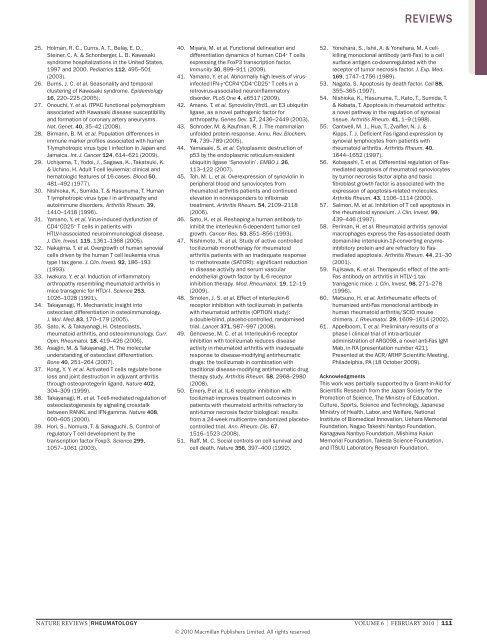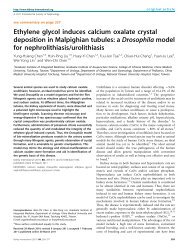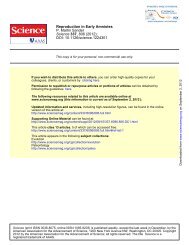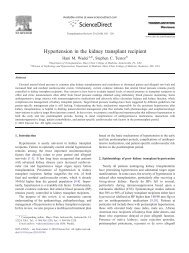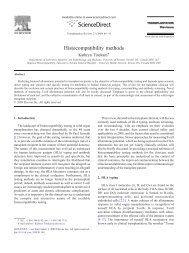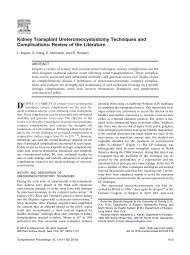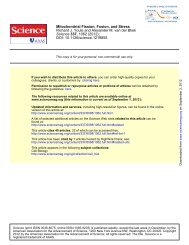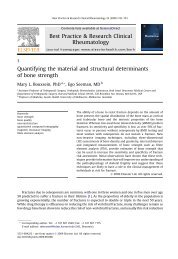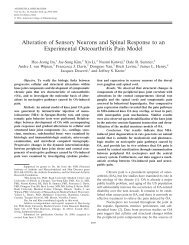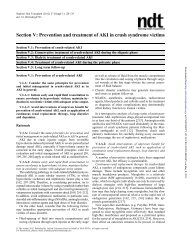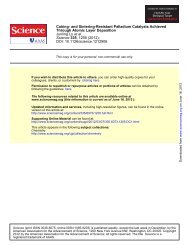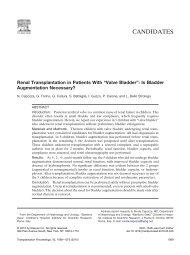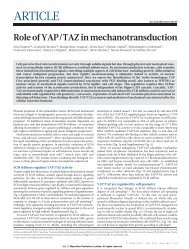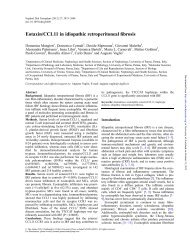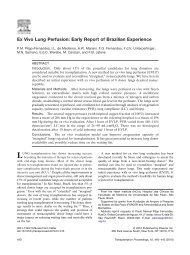The contribution of Asian researchers to the field of rheumatology
The contribution of Asian researchers to the field of rheumatology
The contribution of Asian researchers to the field of rheumatology
Create successful ePaper yourself
Turn your PDF publications into a flip-book with our unique Google optimized e-Paper software.
25. Holman, r. C., Curns, A. T., Belay, e. D.,<br />
Steiner, C. A. & Schonberger, L. B. Kawasaki<br />
syndrome hospitalizations in <strong>the</strong> United States,<br />
1997 and 2000. Pediatrics 112, 495–501<br />
(2003).<br />
26. Burns, J. C. et al. Seasonality and temporal<br />
clustering <strong>of</strong> Kawasaki syndrome. Epidemiology<br />
16, 220–225 (2005).<br />
27. Onouchi, Y. et al. ITPKC functional polymorphism<br />
associated with Kawasaki disease susceptibility<br />
and formation <strong>of</strong> coronary artery aneurysms.<br />
Nat. Genet. 40, 35–42 (2008).<br />
28. Birmann, B. M. et al. Population differences in<br />
immune marker pr<strong>of</strong>iles associated with human<br />
T‑lymphotropic virus type I infection in Japan and<br />
Jamaica. Int. J. Cancer 124, 614–621 (2009).<br />
29. Uchiyama, T., Yodoi, J., Sagawa, K., Takatsuki, K.<br />
& Uchino, H. Adult T‑cell leukemia: clinical and<br />
hema<strong>to</strong>logic features <strong>of</strong> 16 cases. Blood 50,<br />
481–492 (1977).<br />
30. Nishioka, K., Sumida, T. & Hasunuma, T. Human<br />
T lymphotropic virus type I in arthropathy and<br />
au<strong>to</strong>immune disorders. Arthritis Rheum. 39,<br />
1410–1418 (1996).<br />
31. Yamano, Y. et al. Virus‑induced dysfunction <strong>of</strong><br />
CD4 + CD25 + T cells in patients with<br />
HTLV‑I‑associated neuroimmunological disease.<br />
J. Clin. Invest. 115, 1361–1368 (2005).<br />
32. Nakajima, T. et al. Overgrowth <strong>of</strong> human synovial<br />
cells driven by <strong>the</strong> human T cell leukemia virus<br />
type I tax gene. J. Clin. Invest. 92, 186–193<br />
(1993).<br />
33. Iwakura, Y. et al. Induction <strong>of</strong> inflamma<strong>to</strong>ry<br />
arthropathy resembling rheuma<strong>to</strong>id arthritis in<br />
mice transgenic for HTLV‑I. Science 253,<br />
1026–1028 (1991).<br />
34. Takayanagi, H. Mechanistic insight in<strong>to</strong><br />
osteoclast differentiation in osteoimmunology.<br />
J. Mol. Med. 83, 170–179 (2005).<br />
35. Sa<strong>to</strong>, K. & Takayanagi, H. Osteoclasts,<br />
rheuma<strong>to</strong>id arthritis, and osteoimmunology. Curr.<br />
Opin. Rheuma<strong>to</strong>l. 18, 419–426 (2006).<br />
36. Asagiri, M. & Takayanagi, H. <strong>The</strong> molecular<br />
understanding <strong>of</strong> osteoclast differentiation.<br />
Bone 40, 251–264 (2007).<br />
37. Kong, Y. Y. et al. Activated T cells regulate bone<br />
loss and joint destruction in adjuvant arthritis<br />
through osteoprotegerin ligand. Nature 402,<br />
304–309 (1999).<br />
38. Takayanagi, H. et al. T‑cell‑mediated regulation <strong>of</strong><br />
osteoclas<strong>to</strong>genesis by signaling crosstalk<br />
between rANKL and IFN‑gamma. Nature 408,<br />
600–605 (2000).<br />
39. Hori, S., Nomura, T. & Sakaguchi, S. Control <strong>of</strong><br />
regula<strong>to</strong>ry T cell development by <strong>the</strong><br />
transcription fac<strong>to</strong>r Foxp3. Science 299,<br />
1057–1061 (2003).<br />
40. Miyara, M. et al. Functional delineation and<br />
differentiation dynamics <strong>of</strong> human CD4 + T cells<br />
expressing <strong>the</strong> FoxP3 transcription fac<strong>to</strong>r.<br />
Immunity 30, 899–911 (2009).<br />
41. Yamano, Y. et al. Abnormally high levels <strong>of</strong> virus‑<br />
infected IFN‑γ + CCr4 + CD4 + CD25 + T cells in a<br />
retrovirus‑associated neuroinflamma<strong>to</strong>ry<br />
disorder. PLoS One 4, e6517 (2009).<br />
42. Amano. T. et al. Synoviolin/Hrd1, an e3 ubiquitin<br />
ligase, as a novel pathogenic fac<strong>to</strong>r for<br />
arthropathy. Genes Dev. 17, 2436–2449 (2003).<br />
43. Schroder, M. & Kaufman, r. J. <strong>The</strong> mammalian<br />
unfolded protein response. Annu. Rev. Biochem.<br />
74, 739–789 (2005).<br />
44. Yamasaki, S. et al. Cy<strong>to</strong>plasmic destruction <strong>of</strong><br />
p53 by <strong>the</strong> endoplasmic reticulum‑resident<br />
ubiquitin ligase ‘Synoviolin’. EMBO J. 26,<br />
113–122 (2007).<br />
45. Toh, M. L. et al. Overexpression <strong>of</strong> synoviolin in<br />
peripheral blood and synoviocytes from<br />
rheuma<strong>to</strong>id arthritis patients and continued<br />
elevation in nonresponders <strong>to</strong> infliximab<br />
treatment. Arthritis Rheum. 54, 2109–2118<br />
(2006).<br />
46. Sa<strong>to</strong>, K. et al. reshaping a human antibody <strong>to</strong><br />
inhibit <strong>the</strong> interleukin 6‑dependent tumor cell<br />
growth. Cancer Res. 53, 851–856 (1993).<br />
47. Nishimo<strong>to</strong>, N. et al. Study <strong>of</strong> active controlled<br />
<strong>to</strong>cilizumab mono<strong>the</strong>rapy for rheuma<strong>to</strong>id<br />
arthritis patients with an inadequate response<br />
<strong>to</strong> methotrexate (SATOrI): significant reduction<br />
in disease activity and serum vascular<br />
endo<strong>the</strong>lial growth fac<strong>to</strong>r by IL‑6 recep<strong>to</strong>r<br />
inhibition <strong>the</strong>rapy. Mod. Rheuma<strong>to</strong>l. 19, 12–19<br />
(2009).<br />
48. Smolen, J. S. et al. effect <strong>of</strong> interleukin‑6<br />
recep<strong>to</strong>r inhibition with <strong>to</strong>cilizumab in patients<br />
with rheuma<strong>to</strong>id arthritis (OPTION study):<br />
a double‑blind, placebo‑controlled, randomised<br />
trial. Lancet 371, 987–997 (2008).<br />
49. Genovese, M. C. et al. Interleukin‑6 recep<strong>to</strong>r<br />
inhibition with <strong>to</strong>cilizumab reduces disease<br />
activity in rheuma<strong>to</strong>id arthritis with inadequate<br />
response <strong>to</strong> disease‑modifying antirheumatic<br />
drugs: <strong>the</strong> <strong>to</strong>cilizumab in combination with<br />
traditional disease‑modifying antirheumatic drug<br />
<strong>the</strong>rapy study. Arthritis Rheum. 58, 2968–2980<br />
(2008).<br />
50. emery, P. et al. IL‑6 recep<strong>to</strong>r inhibition with<br />
<strong>to</strong>cilizmab improves treatment outcomes in<br />
patients with rheuma<strong>to</strong>id arthritis refrac<strong>to</strong>ry <strong>to</strong><br />
anti‑tumor necrosis fac<strong>to</strong>r biological: results<br />
from a 24‑week multicentre randomized placebo‑<br />
controlled trial. Ann. Rheum. Dis. 67,<br />
1516–1523 (2008).<br />
51. raff, M. C. Social controls on cell survival and<br />
cell death. Nature 356, 397–400 (1992).<br />
reviews<br />
52. Yonehara, S., Ishii, A. & Yonehara, M. A cell‑<br />
killing monoclonal antibody (anti‑Fas) <strong>to</strong> a cell<br />
surface antigen co‑downregulated with <strong>the</strong><br />
recep<strong>to</strong>r <strong>of</strong> tumor necrosis fac<strong>to</strong>r. J. Exp. Med.<br />
169, 1747–1756 (1989).<br />
53. Nagata, S. Apop<strong>to</strong>sis by death fac<strong>to</strong>r. Cell 88,<br />
355–365 (1997).<br />
54. Nishioka, K., Hasunuma, T., Ka<strong>to</strong>, T., Sumida, T.<br />
& Kobata, T. Apop<strong>to</strong>sis in rheuma<strong>to</strong>id arthritis:<br />
a novel pathway in <strong>the</strong> regulation <strong>of</strong> synovial<br />
tissue. Arthritis Rheum. 41, 1–9 (1998).<br />
55. Cantwell, M. J., Hua, T., Zvaifler, N. J. &<br />
Kipps, T. J. Deficient Fas ligand expression by<br />
synovial lymphocytes from patients with<br />
rheuma<strong>to</strong>id arthritis. Arthritis Rheum. 40,<br />
1644–1652 (1997).<br />
56. Kobayashi, T. et al. Differential regulation <strong>of</strong> Fas‑<br />
mediated apop<strong>to</strong>sis <strong>of</strong> rheuma<strong>to</strong>id synoviocytes<br />
by tumor necrosis fac<strong>to</strong>r alpha and basic<br />
fibroblast growth fac<strong>to</strong>r is associated with <strong>the</strong><br />
expression <strong>of</strong> apop<strong>to</strong>sis‑related molecules.<br />
Arthritis Rheum. 43, 1106–1114 (2000).<br />
57. Salmon, M. et al. Inhibition <strong>of</strong> T cell apop<strong>to</strong>sis in<br />
<strong>the</strong> rheuma<strong>to</strong>id synovium. J. Clin. Invest. 99,<br />
439–446 (1997).<br />
58. Perlman, H. et al. rheuma<strong>to</strong>id arthritis synovial<br />
macrophages express <strong>the</strong> Fas‑associated death<br />
domain‑like interleukin‑1β‑converting enzyme‑<br />
inhibi<strong>to</strong>ry protein and are refrac<strong>to</strong>ry <strong>to</strong> Fas‑<br />
mediated apop<strong>to</strong>sis. Arthritis Rheum. 44, 21–30<br />
(2001).<br />
59. Fujisawa, K. et al. <strong>The</strong>rapeutic effect <strong>of</strong> <strong>the</strong> anti‑<br />
Fas antibody on arthritis in HTLV‑1 tax<br />
transgenic mice. J. Clin. Invest. 98, 271–278<br />
(1996).<br />
60. Matsuno, H. et al. Antirheumatic effects <strong>of</strong><br />
humanized anti‑Fas monoclonal antibody in<br />
human rheuma<strong>to</strong>id arthritis/SCID mouse<br />
chimera. J. Rheuma<strong>to</strong>l. 29, 1609–1614 (2002).<br />
61. Appelboom, T. et al. Preliminary results <strong>of</strong> a<br />
phase I clinical trial <strong>of</strong> intra‑articular<br />
administration <strong>of</strong> ArG098, a novel anti‑Fas IgM<br />
Mab, in rA [presentation number 421].<br />
Presented at <strong>the</strong> ACr/ArHP Scientific Meeting,<br />
Philadelphia, PA (18 Oc<strong>to</strong>ber 2009).<br />
Acknowledgments<br />
This work was partially supported by a Grant‑in‑Aid for<br />
Scientific research from <strong>the</strong> Japan Society for <strong>the</strong><br />
Promotion <strong>of</strong> Science, <strong>The</strong> Ministry <strong>of</strong> education,<br />
Culture, Sports, Science and Technology, Japanese<br />
Ministry <strong>of</strong> Health, Labor, and welfare, National<br />
Institute <strong>of</strong> Biomedical Innovation, Uehara Memorial<br />
Foundation, Nagao Takeshi Nanbyo Foundation,<br />
Kanagawa Nanbyo Foundation, Mishima Kaiun<br />
Memorial Foundation, Takeda Science Foundation,<br />
and ITSUU Labora<strong>to</strong>ry research Foundation.<br />
NATuRE REVIEWS | rheumATologY VOLuME 6 | FEBRuARY 2010 | 111<br />
© 20 10<br />
Macmillan Publishers Limited. All rights reserved


